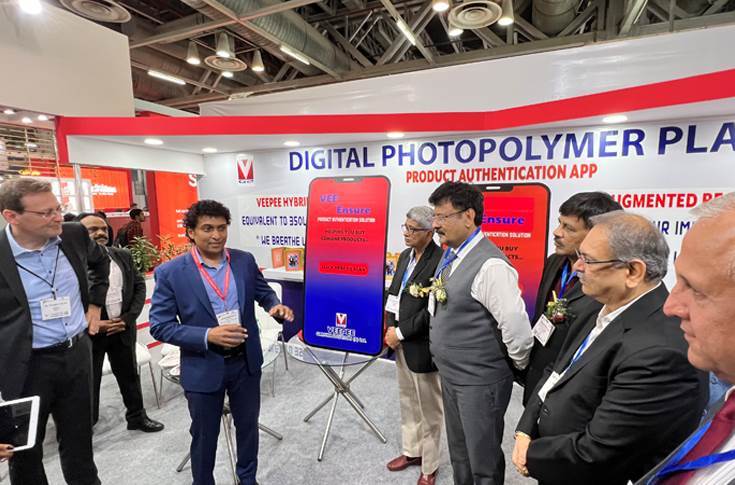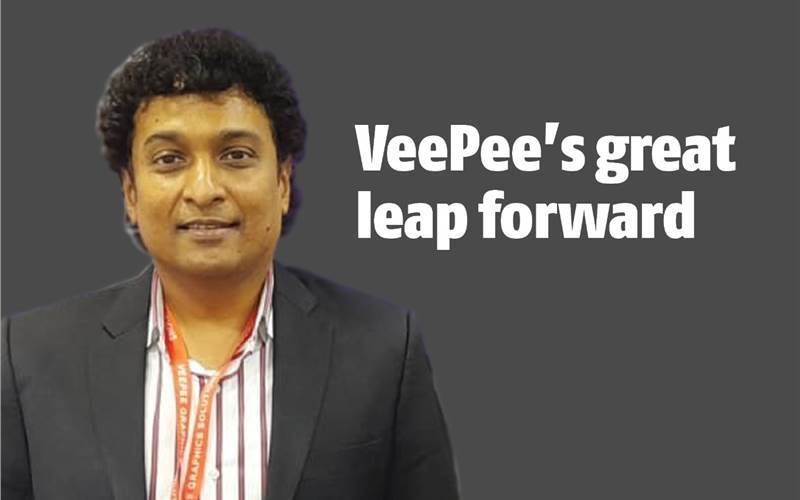VeePee’s great leap forward
When VeePee was the first in the business to supply ready-to-print plates in 2017, the world was a very different place. As more and more label players start to look at flexo as the production process of choice, Jai Chandra talks to Abhay Avadhani about standardisation and the importance of ECG implementation.
12 Nov 2022 | By Abhay Avadhani
Abhay Avadhani (AA): When did the VeePee flexo pre-print journey begin?
Jai Chandra (JC): The post-print quality was not great due to the non availability of good boards. With the advent of automatic board plants that revolutionised the corrugated industry over the last decade, the industry started producing some real high quality boards.
AA: That’s when you made your move?
JC: Yes. Veepee was one of the early entrants into this space and leveraged on the demand for high quality polymer plates and expanded its infrastructure to supply premounted plates up to 2 x 3 metres using automated mounting machines. We were the first trade shop in the country to supply ready-to-print plates back in 2017.
AA: We met last month during the IndiaCorr show in Mumbai. Can you share the details of your creation for the IndiaCorr show?
JC: This edition of the IndiaCorr show was important for the corrugation industry since it was held after a long break. We wanted to showcase the quality of graphics that can be printed on post-print. Therefore, we came up with the idea of distributing a photo frame with high quality graphics printed on one side and a space to insert a photo on the other.
AA: Coming to the prowess of flexo. Would it be fair to say that there is growth in flexo coming at the expense of gravure and offset?
JC: The PS label segment moved from offset to flexo log-stock and barrel. But with flexible packaging, gravure still holds 90% of the market share. I feel this will slowly move to flexo in the future.
AA: Why so?
JC: With the pressure of sustainability, just-in-time supply, lower cost of capex and production, flexo has an edge over gravure which will be the USP. Within the next decade, flexo will overtake gravure in terms of the market share in this segment.
AA: You have spoken about Extended Colour Gamut (ECG) quite a lot. What has been the ECG usage in India?
JC: We have successfully implemented the Extended Colour Gamut (ECG). ECG can be implemented in two ways; one is by introducing OGV into a CMYK image to achieve the gamut which is beyond the colour spectrum of process colours, thereby making the image more vibrant.
ECG can be a successful technology only if we can do fixed pallet printing, which means the inks set of CMYKOGV and the anilox will be constant and the only variable will be the plates.
AA: Got it. What are the advantages?
JC: By implementing this, we can achieve 90% of the Pantone shades which will be a huge saving for the converter because of faster changeovers, no additional cost for pantone inks, cost of press return inks and reduced press set up time. If this technology can be successfully implemented, then the digital flexo doing the rounds in the industry will become a reality.
AA: How does VeePee work in combination with flexo printers to match gravure quality using flexo; as well for significantly exceeding litho laminate results with flexo? How easy is it to create a process-oriented approach - and produce the right flexo plate at the first attempt?
JC: Understanding the concept of colour management and press standardisation and also religiously following it is the only way to success for any converter in this industry. We do not accept any jobs, without doing a fingerprint of the press. We have separate profiles of each substrate that is printed, multiplied by the number of presses installed at a customer site.
AA: How do companies like Tesa SE help VeePee boost its plate mounting standards?
JC: Mounting tape is an integral part of the flexo printing process which can make or break the job. Right selection of tape based on the type of plate and the substrate used is very important. We work in tandem with most of the tape manufacturers to understand their products better which helps us to advise our customers in making the right choice.
AA: Does VeePee have a SOP standard for flexo? How have your packaging partners catered to VeePee in terms of your SOP?
JC: While doing the fingerprint, the print specifications with reference of the ink densities, Lab values and the dot gains are determined. Based on the standardisation process agreed upon by both, us and the converter, the press profiles are created. The only demand from our end is that the converter should walk on the straight line which is mutually accepted as our prepress and plate processing will depend on the SOPs based on the fingerprint. Any deviation in these parameters will have a negative impact on the end results.
AA: India is a gravure nation and the gravure converters have done a fabulous job in image reproduction. The problem is that today's flexo designs are developed keeping in mind gravure. Is this a difficulty?
JC: There are some inherent limitations of the flexo printing process which has to be well understood and accepted at the artwork development stage itself. As both gravure and flexo processes are different, the designs developed for gravure will be a challenging proposition to reproduce in flexo. With the development in the printing machine, anilox rolls, mounting tapes, inks and the plate making technology, we are able to bridge this gap.
AA: How can one overcome this?
JC: By adopting the latest hybrid screening technology, we are able to overcome the barrier of printing high screening rulings in flexo which traditionally is limited to 133 to a maximum of 150 LPI. The latest screening can reproduce dots close to 250 LPI as compared to conventional screening, without any change in the existing printing condition.
AA: I see. The higher the LPI the lower the plate life. Your take on this statement?
JC: Higher the LPI, lower the plate life can be a truth or a myth. With the right selection of inks, anilox, tape, proper printing and plate storage conditions this belief can be a myth. A badly processed plate will make this true as well. Therefore the answer to this question is very subjective.
AA: The COP 27 summit is going in Egypt right now. Sustainability is back in the headlines. What is the sustainability quotient for flexo? What are the challenges and how does flexo compare?
JC: The imagration of ink in gravure is more than that of flexo when it comes to monofilms. The concept of sustainability in flexo starts with the toluene-free inks which gives a major boost to this process. With the flexibility to print films which can lose their dimensional stability under stress, flexo printing is one of the only processes which can overcome this limitation. The development happening with water based inks for flexo will be the game changer which the industry is looking forward to.
AA: It is said that run lengths have shrunk; brands want multi-product portfolios with quick changes and all around cost has become the main focus.
JC: The printing industry is cost-centric and is going in the direction which will further erode the bottom lines. Hence, all the stakeholders should come up with solutions that will satisfy the price pressure, yet justify a healthy bottomline.
AA: What is your take on how flexo makereadies and turnarounds can be optimised?
JC: The printing industry should focus on running the machine at full throttle with minimum changeover and set up time and lower the wastage. With shorter design-to-print turnaround and job changeover time compared to gravure, flexo is the preferred process for brand owners. The development cost also is relatively cheaper in flexo.
AA: What are your plans for the next 12 months?
JC: In the coming future, we will be focusing on the hybrid screening which we presume will take flexo printing to the next level. We have to successfully implement ECG and fixed pallet printing at least at one customer site in the next 12 months. Also living up to the legacy of being a technology driven company, integrating print with the digital media will be one of the core focus areas of Veepee in the coming years.
AA: Any predictions for 2023
JC: 2023 looks very promising for India even though the global economy will be seeing a downward trend with the depression in the horizon.
Veepee launches a new app, Vee Ensure

Jai Chandra of VeePee at the company’s stall in Labelexpo
Bengaluru-based VeePee Graphics Solutions launched an App, Vee Ensure, aimed at product authentication and augmented reality (AR) on the first day of Labelexpo 2022, held at India Expo Mart, Greater Noida from 10 to 13 November.
“This app will help combat the menace of counterfeit, and the AR feature will give the shopping experience a new dimension,” said Jaichandra P, director of VeePee Graphics Solutions.
He added, “The AR can be developed for displaying various applications related to the product, such as the information of the product, the manufacturing process and the functionality of the package and product.”
VeePee also launched the process of producing flexo plates using hybrid screening. The hybrid screening, Veepee claimed, can reproduce a screen ruling of 350 LPI. Jaichandra said, “Flexo printing is being given a different dimension compared to conventional screening.”
VeePee displayed the samples, which said that the Hybrid screening is equivalent to 350 LPI in conventional screening. Jaichandra said, “We have achieved this without making any changes in the flexo printing process.”
Jaichandra believes that in the next five years, the demand for narrow-web flexo will be gone, and the demand for mid-size flexo will increase. “The embellishments done on flexo are inline, which gives good looks and also provides the safety features on the label,” he added.














 See All
See All